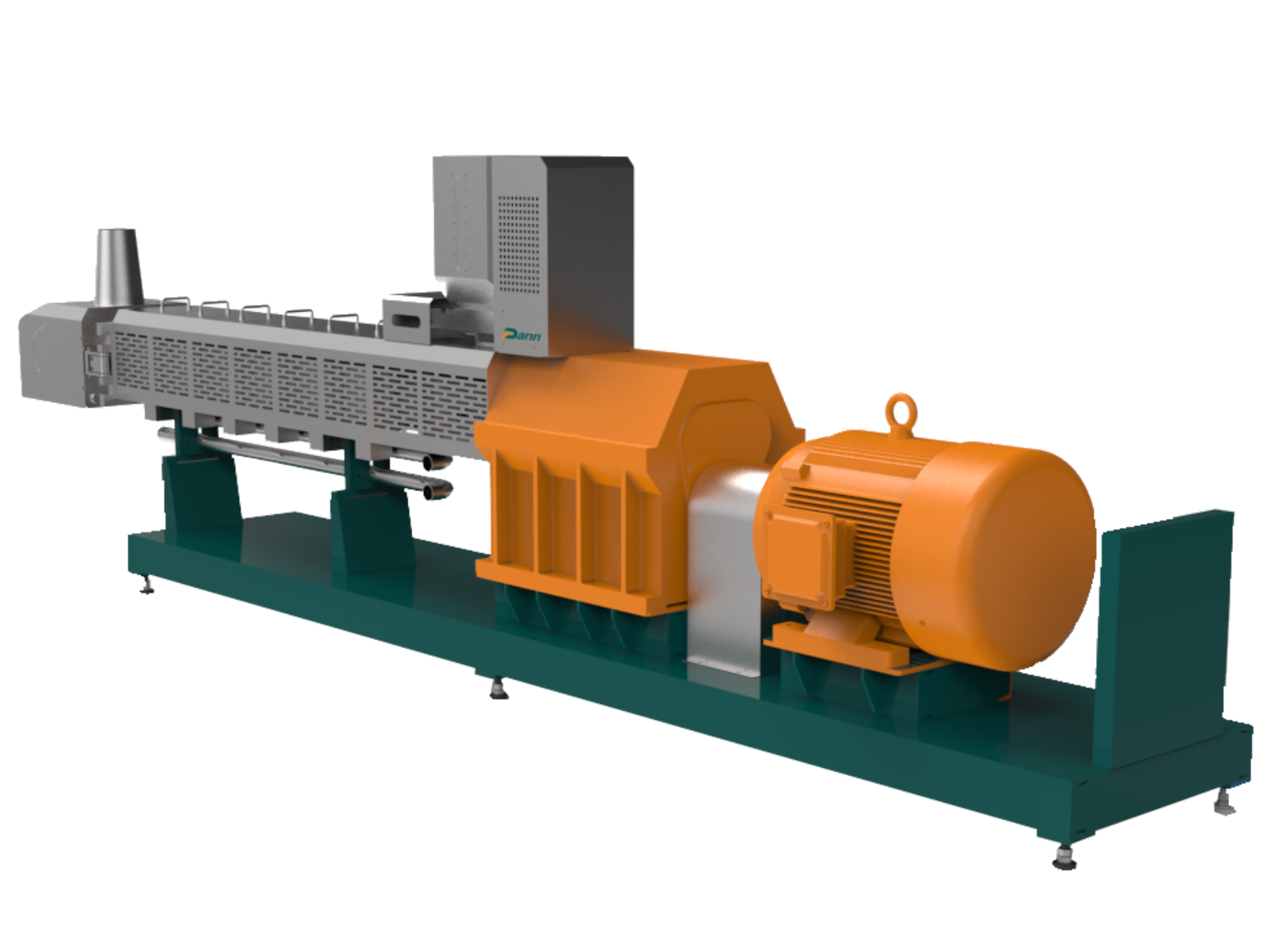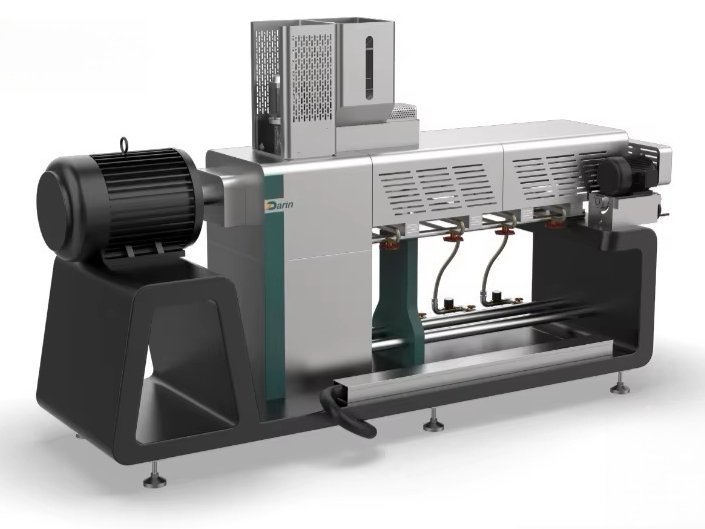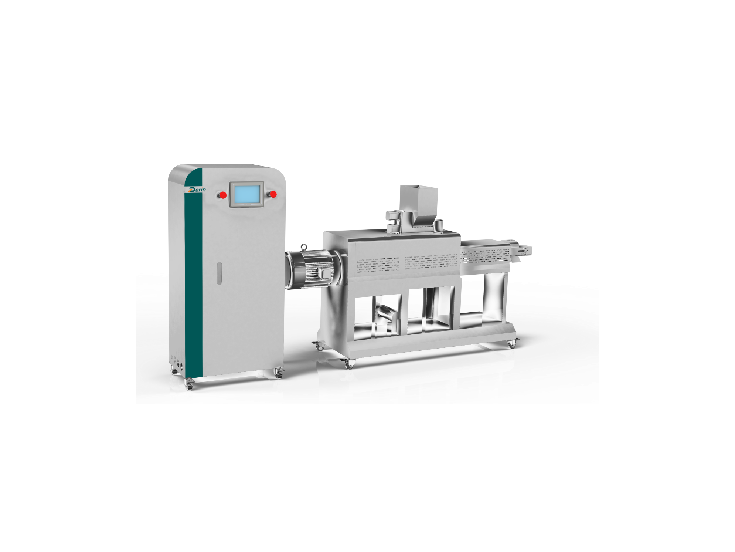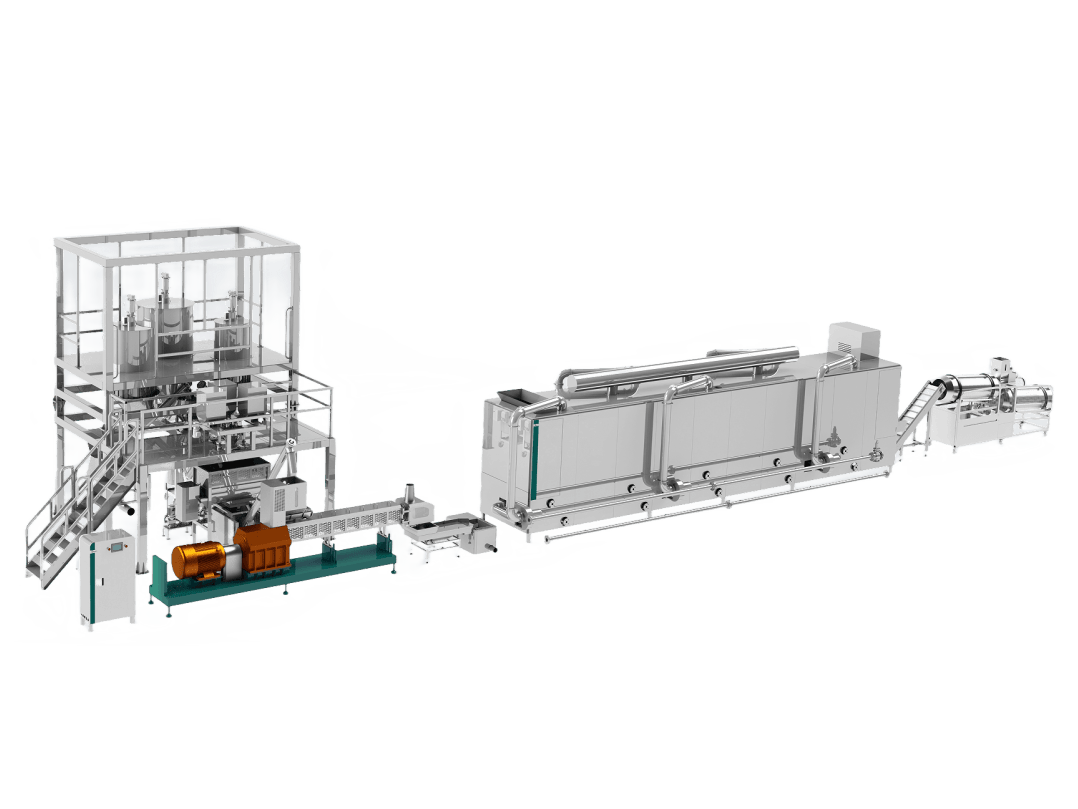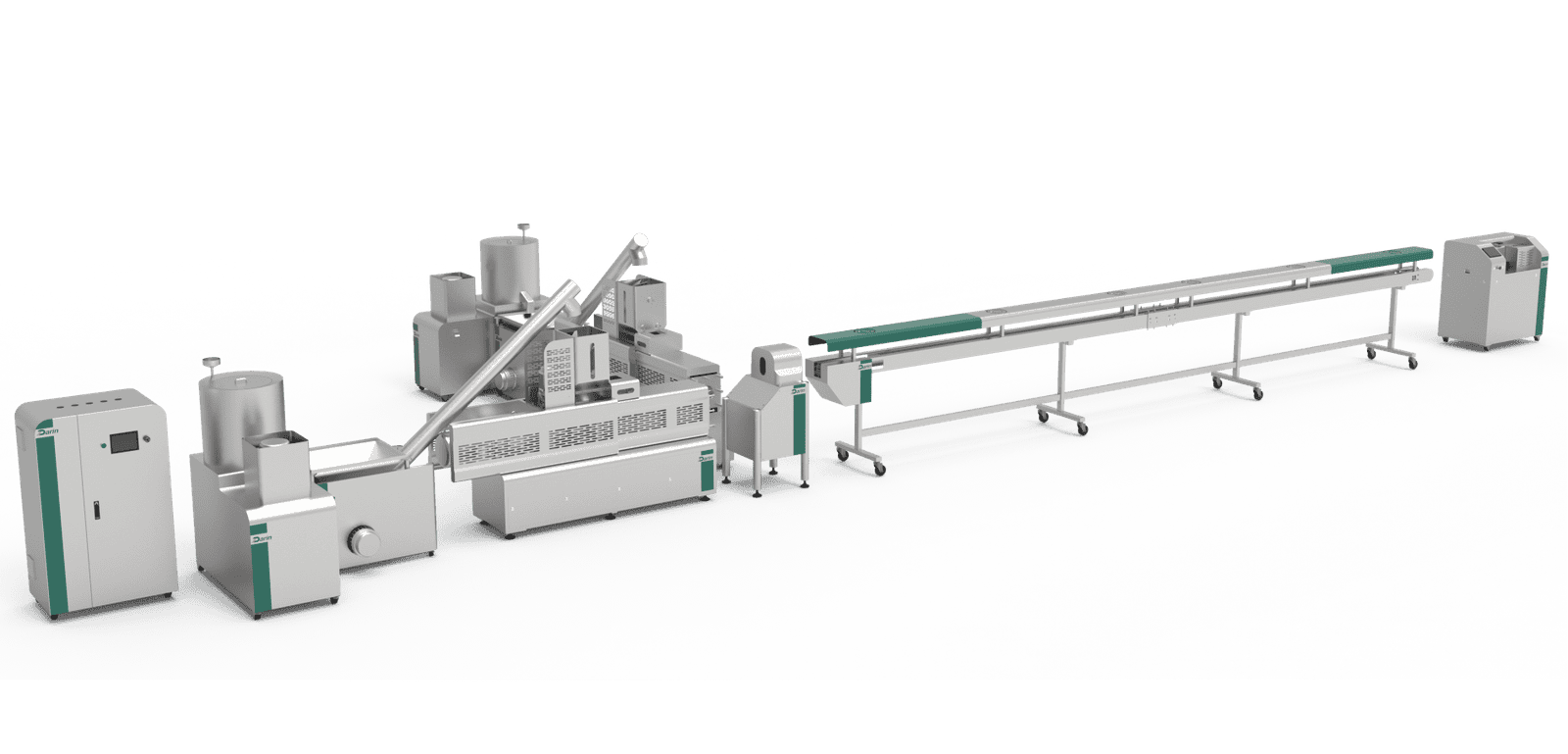
In the pet industry, dog chews have evolved from simple natural bones to highly engineered, nutritionally balanced, and long-lasting treats that meet diverse consumer demands. However, many manufacturers still struggle with issues such as inconsistent texture, poor digestibility, low productivity, or inefficient drying and packaging systems. These challenges directly affect product quality, production cost, and brand reputation. Fortunately, modern automated dog chew production lines—featuring advanced extrusion, forming, and drying technologies—have revolutionized this process, ensuring uniformity, hygiene, and efficiency while enabling innovation in flavor, shape, and functionality.
Dog chew production refers to the industrial process of manufacturing edible chewable treats designed for dogs to promote dental health, satisfy chewing instincts, and deliver nutritional benefits. Modern dog chew production has evolved from manual and natural bone processing into a fully automated, hygienic, and scalable system involving raw material preparation, extrusion, shaping, cutting, drying, flavoring, cooling, and packaging.
As global pet ownership expands, the market’s appetite for premium, healthy, and functional dog chews continues to surge. Consumers now expect not just a treat but a product that supports joint health, oral hygiene, and even specific dietary needs such as grain-free or protein-rich formulas. This transformation has driven both technological innovation and process optimization in the manufacturing sector.
Dog chews are made only from rawhide.False
Modern dog chews include a wide range of ingredients such as starch, meat, collagen, and plant-based proteins, not just rawhide.
Extrusion technology is the foundation of modern dog chew manufacturing.True
Extrusion ensures consistent texture, sterilization, and nutritional control, making it central to industrial dog chew production.
Evolution of Dog Chew Production: From Rawhide to Functional Treats
1. The Early Stage — Natural and Rawhide Chews
In the 1970s–1980s, dog chews primarily consisted of rawhide bones, dried animal parts, or simple meat strips. These early products offered basic chewing satisfaction but often lacked nutritional control and uniform quality. The production process was largely manual—boiling, drying, and hand-cutting rawhide—resulting in variable texture and hygiene standards.
| Era | Material Type | Production Method | Key Features | Limitations |
|---|---|---|---|---|
| 1970s–1980s | Rawhide, pig ears, bones | Manual cutting and drying | Natural appeal, low cost | Poor digestibility, hygiene risk |
| 1990s | Pressed hides, meat jerky | Semi-automatic drying | Improved durability | Limited shape innovation |
| 2000s–2020s | Extruded starch/meat chews | Fully automated extrusion | Customizable, safe, nutritious | Higher equipment investment |
2. The Modern Stage — Extrusion and Composite Materials
The introduction of twin-screw extrusion technology in the 1990s–2000s transformed dog chew manufacturing. Extruders allowed precise control of temperature, pressure, and shear, enabling new textures such as twisted, layered, or filled chews. Formulations became more diverse, incorporating starches, proteins, collagen, glycerin, and natural colorants.
Key process improvements:
- Automatic mixing and dosing systems ensure consistent material blending.
- Twin-screw extruders create flexible textures and sterilize ingredients simultaneously.
- Forming and cutting machines produce various shapes (sticks, twists, bones, rings).
- Continuous drying ovens guarantee uniform moisture content.
- Flavoring and coating drums enhance palatability and appearance.
| Equipment Type | Function | Process Parameter Range |
|---|---|---|
| Mixer | Blend raw materials | 5–10 min / 25–35°C |
| Twin-Screw Extruder | Cook & form chew dough | 90–150°C / 100–300 rpm |
| Forming Machine | Shape products | Adjustable molds |
| Dryer | Remove moisture | 60–90°C for 1–3 hours |
| Cooling Conveyor | Stabilize texture | 10–15 min |
| Flavor Coating Drum | Apply oils, flavor | Uniform coating |
| Packaging Machine | Seal final product | Air-tight pouches |
3. The Functional and Premium Era — 2010s to Present
As pet humanization and health awareness rise, today’s dog chews focus on functionality, safety, and premium sensory experience. Manufacturers integrate vitamins, minerals, and nutraceuticals such as glucosamine, collagen, and probiotics. Sustainable and plant-based materials are gaining traction as eco-friendly alternatives.
Key trends shaping the current market:
- Grain-free & allergen-friendly formulations (e.g., potato, pea starch, soy protein).
- Functional chews for oral care, joint health, or anxiety reduction.
- 3D-shaped chews via precision mold extrusion.
- High-protein and low-fat variants for specific diets.
- Sustainable packaging and eco-compliance with food safety standards (HACCP, ISO22000, CE).
| Product Type | Functional Ingredient | Market Example |
|---|---|---|
| Dental Chews | Sodium hexametaphosphate, mint | Greenies, Whimzees |
| Protein Chews | Chicken, fish, collagen | SmartBones |
| Vegetarian Chews | Potato starch, rice flour | VeggieDent |
| Functional Chews | Glucosamine, omega-3 | Pedigree DentaFlex |
4. Future Directions: Smart Manufacturing and Sustainability
The future of dog chew production lies in Industry 4.0 integration and green innovation. Manufacturers are adopting digital monitoring systems, predictive maintenance, and AI-based quality control to achieve zero-defect production.
Emerging trends include:
- IoT-enabled extruders for real-time process optimization.
- Energy-efficient dryers reducing carbon footprint by 20–30%.
- Biodegradable chew materials using plant-based polymers.
- Data-driven formulation control improving consistency and reducing waste.
Projected Global Dog Chew Market Growth (2020–2030):
| Year | Global Market Size (USD Billion) | CAGR |
|---|---|---|
| 2020 | 1.8 | — |
| 2025 | 3.2 | 10.5% |
| 2030 (forecast) | 5.1 | 9.7% |
Why Extrusion Is the Heart of Modern Dog Chew Manufacturing
Extrusion technology combines cooking, shaping, sterilization, and texturizing in one continuous process. By controlling screw speed, moisture, and temperature, manufacturers can produce chews with desired hardness, elasticity, and density.
Advantages of extrusion-based dog chew production:
- Precise control over texture and chew resistance.
- High-temperature short-time (HTST) sterilization for food safety.
- Capability to use varied raw materials—meat, starch, collagen, or vegetable protein.
- Lower energy consumption compared to traditional drying.
- Scalability and easy recipe customization.
Example:
A 300 kg/h Darin twin-screw extrusion line can process starch-based raw materials into shaped chews within 15 minutes, using only 30 kWh of power—reducing production time and labor cost significantly while maintaining consistent quality.
Challenges in Dog Chew Production
Even with modern systems, manufacturers must carefully control critical parameters:
- Moisture content: Ideal final range 12–18% to prevent mold and ensure chewability.
- Temperature profile: Overheating can degrade protein; underheating leads to microbial risk.
- Ingredient sourcing: Quality of starch and collagen affects elasticity.
- Drying balance: Too rapid drying causes cracks; too slow reduces efficiency.
- Hygiene management: Compliance with GMP and HACCP standards is non-negotiable.
| Parameter | Ideal Range | Effect of Deviation |
|---|---|---|
| Moisture | 12–18% | Mold or brittleness |
| Extrusion Temp | 90–150°C | Poor texture or contamination |
| Drying Time | 1–3 h | Cracks or excessive hardness |
| Storage Humidity | < 65% RH | Prevents microbial growth |
Darin Dog Chew Production Line
At Darin Machinery, we have engineered turnkey dog chew production lines with capacities ranging from 100 kg/h to 1 ton/h. Our systems integrate automatic dosing, extrusion, forming, and drying, minimizing manual intervention and maximizing output consistency.
Key features:
- Twin-screw extruder with modular design for flexible recipe switching.
- Mold-change system for producing twisted, knotted, or sandwich-type chews.
- Energy-efficient hot-air dryers with intelligent humidity control.
- Customizable flavor coating and packaging units.
Technical Overview:
| Model | Capacity | Power Consumption | Dimensions | Applicable Chew Types |
|---|---|---|---|---|
| DRD-100 | 100 kg/h | 22 kW | 20×2×3 m | Small sticks, dental |
| DRD-300 | 300 kg/h | 45 kW | 28×2.5×3 m | Twisted, layered |
| DRD-500 | 500 kg/h | 70 kW | 35×3×4 m | Filled or large bones |
| DRD-1000 | 1000 kg/h | 120 kW | 45×3×4 m | Mixed meat & starch chews |
Conclusion
Dog chew production has evolved from rudimentary rawhide processing into a sophisticated, data-driven food manufacturing discipline. With extrusion, automation, and formulation science at its core, modern facilities can produce safer, tastier, and more diverse chews than ever before. The future promises even smarter, greener, and more functional products tailored to the health and happiness of pets worldwide.
Talk to Us — Your Partner in Dog Chew Production Innovation
At Darin Machinery, we specialize in complete dog chew and pet treat production lines—from extrusion to drying and packaging. Whether you are launching a new product or upgrading your factory to meet global standards, our engineering team can help you design a custom, efficient, and profitable solution.
📞 WhatsApp: +86 156 5000 7983
📧 Email: darin4@darin.cn
🌐 Website: www.petreatsmachine.com


